Case Study: Major Depressive Episode in Postpartum Period
VerifiedAdded on 2022/10/08
|13
|3550
|13
Case Study
AI Summary
This case study analyzes a patient experiencing a major depressive episode in the postpartum period, with a comorbidity of hypothyroidism. The assignment delves into the patient's history, symptoms, and the tests conducted, including urine drug screens, thyroid hormone tests, ECGs, and depression screening tests. It critiques the rationale for the recommended medical treatments, such as Zoloft, thyroxine, lorazepam, and quetiapine, discussing their mechanisms of action and dosages. The study also examines the relevance of the discharge plan, including the importance of multidisciplinary teams and ongoing medication management to help the patient manage her condition and transition from clinical to home settings. The assignment emphasizes the challenges of managing a chronic condition like major depressive disorder and highlights the need for continued support and medication adherence.
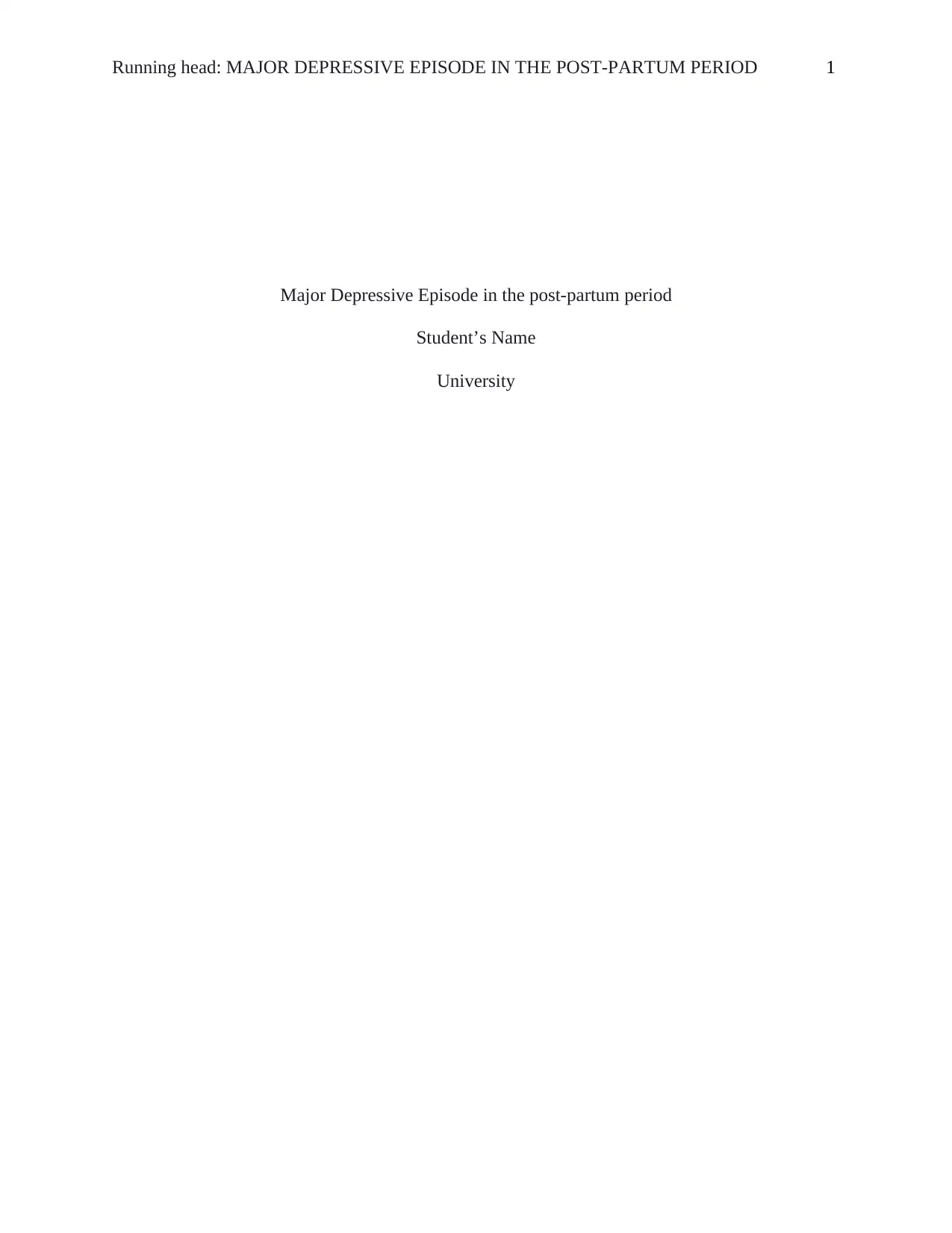
Running head: MAJOR DEPRESSIVE EPISODE IN THE POST-PARTUM PERIOD 1
Major Depressive Episode in the post-partum period
Student’s Name
University
Major Depressive Episode in the post-partum period
Student’s Name
University
Paraphrase This Document
Need a fresh take? Get an instant paraphrase of this document with our AI Paraphraser
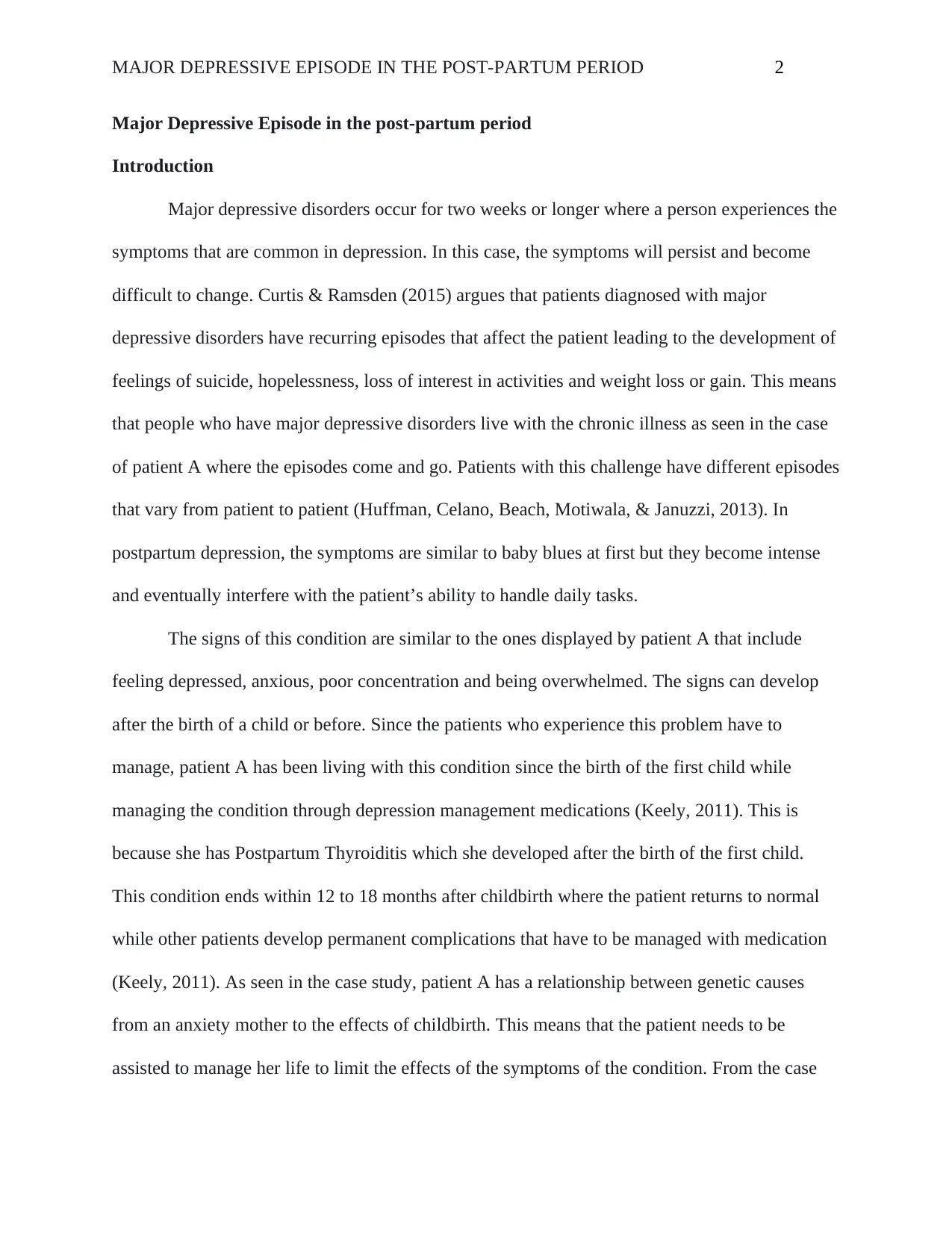
MAJOR DEPRESSIVE EPISODE IN THE POST-PARTUM PERIOD 2
Major Depressive Episode in the post-partum period
Introduction
Major depressive disorders occur for two weeks or longer where a person experiences the
symptoms that are common in depression. In this case, the symptoms will persist and become
difficult to change. Curtis & Ramsden (2015) argues that patients diagnosed with major
depressive disorders have recurring episodes that affect the patient leading to the development of
feelings of suicide, hopelessness, loss of interest in activities and weight loss or gain. This means
that people who have major depressive disorders live with the chronic illness as seen in the case
of patient A where the episodes come and go. Patients with this challenge have different episodes
that vary from patient to patient (Huffman, Celano, Beach, Motiwala, & Januzzi, 2013). In
postpartum depression, the symptoms are similar to baby blues at first but they become intense
and eventually interfere with the patient’s ability to handle daily tasks.
The signs of this condition are similar to the ones displayed by patient A that include
feeling depressed, anxious, poor concentration and being overwhelmed. The signs can develop
after the birth of a child or before. Since the patients who experience this problem have to
manage, patient A has been living with this condition since the birth of the first child while
managing the condition through depression management medications (Keely, 2011). This is
because she has Postpartum Thyroiditis which she developed after the birth of the first child.
This condition ends within 12 to 18 months after childbirth where the patient returns to normal
while other patients develop permanent complications that have to be managed with medication
(Keely, 2011). As seen in the case study, patient A has a relationship between genetic causes
from an anxiety mother to the effects of childbirth. This means that the patient needs to be
assisted to manage her life to limit the effects of the symptoms of the condition. From the case
Major Depressive Episode in the post-partum period
Introduction
Major depressive disorders occur for two weeks or longer where a person experiences the
symptoms that are common in depression. In this case, the symptoms will persist and become
difficult to change. Curtis & Ramsden (2015) argues that patients diagnosed with major
depressive disorders have recurring episodes that affect the patient leading to the development of
feelings of suicide, hopelessness, loss of interest in activities and weight loss or gain. This means
that people who have major depressive disorders live with the chronic illness as seen in the case
of patient A where the episodes come and go. Patients with this challenge have different episodes
that vary from patient to patient (Huffman, Celano, Beach, Motiwala, & Januzzi, 2013). In
postpartum depression, the symptoms are similar to baby blues at first but they become intense
and eventually interfere with the patient’s ability to handle daily tasks.
The signs of this condition are similar to the ones displayed by patient A that include
feeling depressed, anxious, poor concentration and being overwhelmed. The signs can develop
after the birth of a child or before. Since the patients who experience this problem have to
manage, patient A has been living with this condition since the birth of the first child while
managing the condition through depression management medications (Keely, 2011). This is
because she has Postpartum Thyroiditis which she developed after the birth of the first child.
This condition ends within 12 to 18 months after childbirth where the patient returns to normal
while other patients develop permanent complications that have to be managed with medication
(Keely, 2011). As seen in the case study, patient A has a relationship between genetic causes
from an anxiety mother to the effects of childbirth. This means that the patient needs to be
assisted to manage her life to limit the effects of the symptoms of the condition. From the case

MAJOR DEPRESSIVE EPISODE IN THE POST-PARTUM PERIOD 3
study patient A seems to be suffering from a Major Depressive Episode in the post-partum
period with comorbidity of hypothyroidism on suboptimal thyroxin management
Critique of Tests carried out
A urine drug screen is used to detect the presence of drugs within the body of the patient.
This is done through urine samples that are used to detect a range of drugs mostly for detecting
nicotine and cotinine. Thyroid hormones produce thyroxine (T4) and triiodothyronine (T3) that
play an important role in the thermo genic and metabolic homeostasis process to balance the
hormones within the body (Abraham & Luty, 2010). The role of UDS screening is to determine
the types of drugs that the patient may be using which could be triggers of the symptoms or they
can affect the management of the condition. Alcohol and other recreational drugs can cause
depression in patients since they affect the normal functioning of the body.
Choon (2011) states that blood thyroid tests are used to measure the functioning of the
thyroid gland. The common tests carried out are T3, T3RU, T4, and TSH. The functioning of the
thyroid is seen in the production of T3 and T4 hormones and thus when they are low in the body,
the patient feels depressed and experiences the common symptoms associated with the problem
(Ionescu, Rosenbaum, & Alpert, 2015). In the T4 test, a high level of T4 indicates an overactive
thyroid (hyperthyroidism). The TSH test is used to measure the level of thyroid-stimulating
hormone in the blood (Raj, 2014). The normal TSH test ranges between 0.4 and 4.0 milli-
international units of hormone per liter of blood. If the patient shows TSH readings above 2.0
mIU/L then the patient is progressing to hypothyroidism. Choon (2011) suggests that T3 tests are
used to test the hormone triiodothyronine and is usually ordered if T4 and TSH tests suggest
hyperthyroidism or if the patient shows signs of an overactive thyroid gland. The normal range
for T3 is 100–200 nanograms of hormone per deciliter of blood (ng/dl) (Choon, 2011).
study patient A seems to be suffering from a Major Depressive Episode in the post-partum
period with comorbidity of hypothyroidism on suboptimal thyroxin management
Critique of Tests carried out
A urine drug screen is used to detect the presence of drugs within the body of the patient.
This is done through urine samples that are used to detect a range of drugs mostly for detecting
nicotine and cotinine. Thyroid hormones produce thyroxine (T4) and triiodothyronine (T3) that
play an important role in the thermo genic and metabolic homeostasis process to balance the
hormones within the body (Abraham & Luty, 2010). The role of UDS screening is to determine
the types of drugs that the patient may be using which could be triggers of the symptoms or they
can affect the management of the condition. Alcohol and other recreational drugs can cause
depression in patients since they affect the normal functioning of the body.
Choon (2011) states that blood thyroid tests are used to measure the functioning of the
thyroid gland. The common tests carried out are T3, T3RU, T4, and TSH. The functioning of the
thyroid is seen in the production of T3 and T4 hormones and thus when they are low in the body,
the patient feels depressed and experiences the common symptoms associated with the problem
(Ionescu, Rosenbaum, & Alpert, 2015). In the T4 test, a high level of T4 indicates an overactive
thyroid (hyperthyroidism). The TSH test is used to measure the level of thyroid-stimulating
hormone in the blood (Raj, 2014). The normal TSH test ranges between 0.4 and 4.0 milli-
international units of hormone per liter of blood. If the patient shows TSH readings above 2.0
mIU/L then the patient is progressing to hypothyroidism. Choon (2011) suggests that T3 tests are
used to test the hormone triiodothyronine and is usually ordered if T4 and TSH tests suggest
hyperthyroidism or if the patient shows signs of an overactive thyroid gland. The normal range
for T3 is 100–200 nanograms of hormone per deciliter of blood (ng/dl) (Choon, 2011).
⊘ This is a preview!⊘
Do you want full access?
Subscribe today to unlock all pages.

Trusted by 1+ million students worldwide

MAJOR DEPRESSIVE EPISODE IN THE POST-PARTUM PERIOD 4
According to Wang, et al. (2013) ECG tests can be used to determine the nature of
depression of the patient. ECG tests are used to diagnose heart problems in the patient which can
be caused by other complications. According to Huffman, Celano, Beach, Motiwala, & Januzzi
(2013) people with heart disease are likely to develop depression complications because
depression affects the body since they are related to heart problems. This means that when
people are diagnosed with heart disease, they become moody, irritable or distressed which can
lead to depression.
Depression screening test is also used to assess the symptoms in the patient that point to
the existence of depression (Huffman, Celano, Beach, Motiwala, & Januzzi, 2013). There are
several depression screening instruments that are used in clinical situations. The tests have a
range of questions that are used to assess the state of the patient where basic questions focus on
the feeling of the patient and how the signs and symptoms that the patient feels have been
portrayed (Levis, Benedetti, & Thombs, 2019). It is important to note that the duration of the
symptoms is important since depression can only be diagnosed in a patient if the signs and
symptoms have been experienced for more than two weeks.
The rationale for recommended medical treatment of the patient
Ionescu, Rosenbaum, & Alpert (2015) argues that aantidepressants are used to relieve the
symptoms faced by the patient through correcting the chemical imbalances of neurotransmitters
which affect mood behavior. Zoloft is used for the treatment of depression and other mental
health conditions in patients (Ionescu, Rosenbaum, & Alpert, 2015). Being an antidepressant the
drug works by increasing the level of serotonin in the brain. The effectiveness of the drug works
by improving mood, sleep, energy levels, and appetite which can restore the interest of the
patient (Ionescu, Rosenbaum, & Alpert, 2015). This drug also decreases fear, anxiety and
According to Wang, et al. (2013) ECG tests can be used to determine the nature of
depression of the patient. ECG tests are used to diagnose heart problems in the patient which can
be caused by other complications. According to Huffman, Celano, Beach, Motiwala, & Januzzi
(2013) people with heart disease are likely to develop depression complications because
depression affects the body since they are related to heart problems. This means that when
people are diagnosed with heart disease, they become moody, irritable or distressed which can
lead to depression.
Depression screening test is also used to assess the symptoms in the patient that point to
the existence of depression (Huffman, Celano, Beach, Motiwala, & Januzzi, 2013). There are
several depression screening instruments that are used in clinical situations. The tests have a
range of questions that are used to assess the state of the patient where basic questions focus on
the feeling of the patient and how the signs and symptoms that the patient feels have been
portrayed (Levis, Benedetti, & Thombs, 2019). It is important to note that the duration of the
symptoms is important since depression can only be diagnosed in a patient if the signs and
symptoms have been experienced for more than two weeks.
The rationale for recommended medical treatment of the patient
Ionescu, Rosenbaum, & Alpert (2015) argues that aantidepressants are used to relieve the
symptoms faced by the patient through correcting the chemical imbalances of neurotransmitters
which affect mood behavior. Zoloft is used for the treatment of depression and other mental
health conditions in patients (Ionescu, Rosenbaum, & Alpert, 2015). Being an antidepressant the
drug works by increasing the level of serotonin in the brain. The effectiveness of the drug works
by improving mood, sleep, energy levels, and appetite which can restore the interest of the
patient (Ionescu, Rosenbaum, & Alpert, 2015). This drug also decreases fear, anxiety and
Paraphrase This Document
Need a fresh take? Get an instant paraphrase of this document with our AI Paraphraser
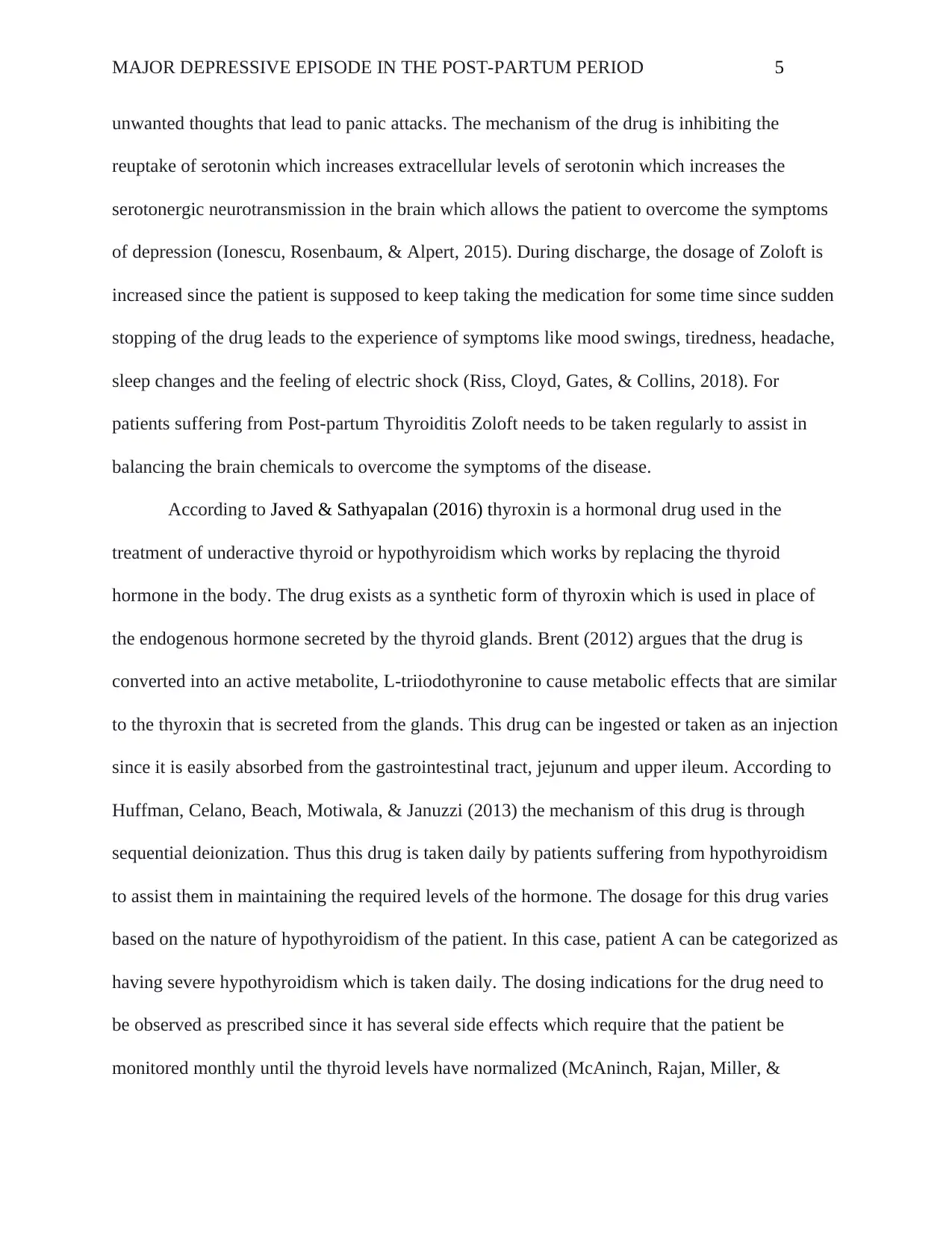
MAJOR DEPRESSIVE EPISODE IN THE POST-PARTUM PERIOD 5
unwanted thoughts that lead to panic attacks. The mechanism of the drug is inhibiting the
reuptake of serotonin which increases extracellular levels of serotonin which increases the
serotonergic neurotransmission in the brain which allows the patient to overcome the symptoms
of depression (Ionescu, Rosenbaum, & Alpert, 2015). During discharge, the dosage of Zoloft is
increased since the patient is supposed to keep taking the medication for some time since sudden
stopping of the drug leads to the experience of symptoms like mood swings, tiredness, headache,
sleep changes and the feeling of electric shock (Riss, Cloyd, Gates, & Collins, 2018). For
patients suffering from Post-partum Thyroiditis Zoloft needs to be taken regularly to assist in
balancing the brain chemicals to overcome the symptoms of the disease.
According to Javed & Sathyapalan (2016) thyroxin is a hormonal drug used in the
treatment of underactive thyroid or hypothyroidism which works by replacing the thyroid
hormone in the body. The drug exists as a synthetic form of thyroxin which is used in place of
the endogenous hormone secreted by the thyroid glands. Brent (2012) argues that the drug is
converted into an active metabolite, L-triiodothyronine to cause metabolic effects that are similar
to the thyroxin that is secreted from the glands. This drug can be ingested or taken as an injection
since it is easily absorbed from the gastrointestinal tract, jejunum and upper ileum. According to
Huffman, Celano, Beach, Motiwala, & Januzzi (2013) the mechanism of this drug is through
sequential deionization. Thus this drug is taken daily by patients suffering from hypothyroidism
to assist them in maintaining the required levels of the hormone. The dosage for this drug varies
based on the nature of hypothyroidism of the patient. In this case, patient A can be categorized as
having severe hypothyroidism which is taken daily. The dosing indications for the drug need to
be observed as prescribed since it has several side effects which require that the patient be
monitored monthly until the thyroid levels have normalized (McAninch, Rajan, Miller, &
unwanted thoughts that lead to panic attacks. The mechanism of the drug is inhibiting the
reuptake of serotonin which increases extracellular levels of serotonin which increases the
serotonergic neurotransmission in the brain which allows the patient to overcome the symptoms
of depression (Ionescu, Rosenbaum, & Alpert, 2015). During discharge, the dosage of Zoloft is
increased since the patient is supposed to keep taking the medication for some time since sudden
stopping of the drug leads to the experience of symptoms like mood swings, tiredness, headache,
sleep changes and the feeling of electric shock (Riss, Cloyd, Gates, & Collins, 2018). For
patients suffering from Post-partum Thyroiditis Zoloft needs to be taken regularly to assist in
balancing the brain chemicals to overcome the symptoms of the disease.
According to Javed & Sathyapalan (2016) thyroxin is a hormonal drug used in the
treatment of underactive thyroid or hypothyroidism which works by replacing the thyroid
hormone in the body. The drug exists as a synthetic form of thyroxin which is used in place of
the endogenous hormone secreted by the thyroid glands. Brent (2012) argues that the drug is
converted into an active metabolite, L-triiodothyronine to cause metabolic effects that are similar
to the thyroxin that is secreted from the glands. This drug can be ingested or taken as an injection
since it is easily absorbed from the gastrointestinal tract, jejunum and upper ileum. According to
Huffman, Celano, Beach, Motiwala, & Januzzi (2013) the mechanism of this drug is through
sequential deionization. Thus this drug is taken daily by patients suffering from hypothyroidism
to assist them in maintaining the required levels of the hormone. The dosage for this drug varies
based on the nature of hypothyroidism of the patient. In this case, patient A can be categorized as
having severe hypothyroidism which is taken daily. The dosing indications for the drug need to
be observed as prescribed since it has several side effects which require that the patient be
monitored monthly until the thyroid levels have normalized (McAninch, Rajan, Miller, &
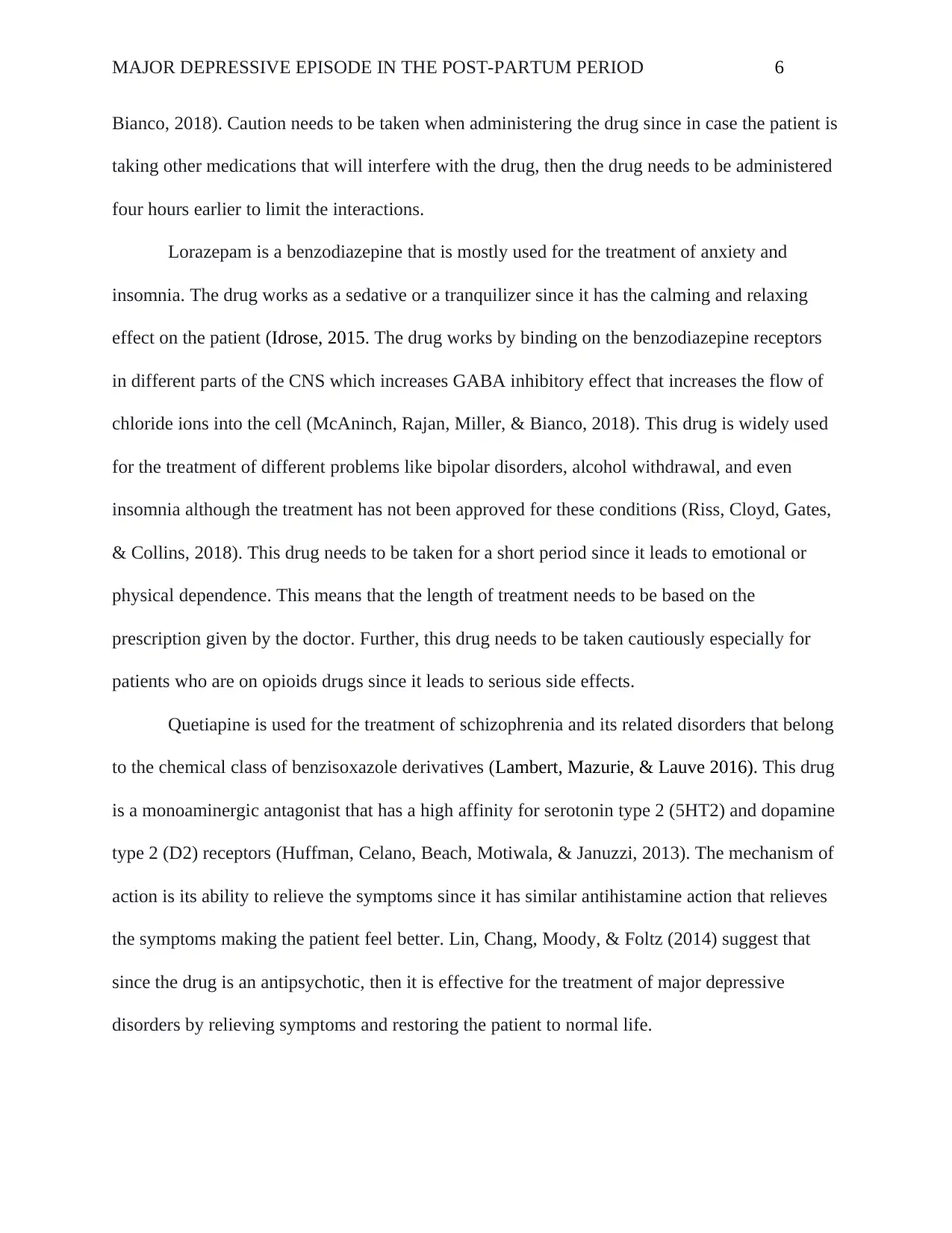
MAJOR DEPRESSIVE EPISODE IN THE POST-PARTUM PERIOD 6
Bianco, 2018). Caution needs to be taken when administering the drug since in case the patient is
taking other medications that will interfere with the drug, then the drug needs to be administered
four hours earlier to limit the interactions.
Lorazepam is a benzodiazepine that is mostly used for the treatment of anxiety and
insomnia. The drug works as a sedative or a tranquilizer since it has the calming and relaxing
effect on the patient (Idrose, 2015. The drug works by binding on the benzodiazepine receptors
in different parts of the CNS which increases GABA inhibitory effect that increases the flow of
chloride ions into the cell (McAninch, Rajan, Miller, & Bianco, 2018). This drug is widely used
for the treatment of different problems like bipolar disorders, alcohol withdrawal, and even
insomnia although the treatment has not been approved for these conditions (Riss, Cloyd, Gates,
& Collins, 2018). This drug needs to be taken for a short period since it leads to emotional or
physical dependence. This means that the length of treatment needs to be based on the
prescription given by the doctor. Further, this drug needs to be taken cautiously especially for
patients who are on opioids drugs since it leads to serious side effects.
Quetiapine is used for the treatment of schizophrenia and its related disorders that belong
to the chemical class of benzisoxazole derivatives (Lambert, Mazurie, & Lauve 2016). This drug
is a monoaminergic antagonist that has a high affinity for serotonin type 2 (5HT2) and dopamine
type 2 (D2) receptors (Huffman, Celano, Beach, Motiwala, & Januzzi, 2013). The mechanism of
action is its ability to relieve the symptoms since it has similar antihistamine action that relieves
the symptoms making the patient feel better. Lin, Chang, Moody, & Foltz (2014) suggest that
since the drug is an antipsychotic, then it is effective for the treatment of major depressive
disorders by relieving symptoms and restoring the patient to normal life.
Bianco, 2018). Caution needs to be taken when administering the drug since in case the patient is
taking other medications that will interfere with the drug, then the drug needs to be administered
four hours earlier to limit the interactions.
Lorazepam is a benzodiazepine that is mostly used for the treatment of anxiety and
insomnia. The drug works as a sedative or a tranquilizer since it has the calming and relaxing
effect on the patient (Idrose, 2015. The drug works by binding on the benzodiazepine receptors
in different parts of the CNS which increases GABA inhibitory effect that increases the flow of
chloride ions into the cell (McAninch, Rajan, Miller, & Bianco, 2018). This drug is widely used
for the treatment of different problems like bipolar disorders, alcohol withdrawal, and even
insomnia although the treatment has not been approved for these conditions (Riss, Cloyd, Gates,
& Collins, 2018). This drug needs to be taken for a short period since it leads to emotional or
physical dependence. This means that the length of treatment needs to be based on the
prescription given by the doctor. Further, this drug needs to be taken cautiously especially for
patients who are on opioids drugs since it leads to serious side effects.
Quetiapine is used for the treatment of schizophrenia and its related disorders that belong
to the chemical class of benzisoxazole derivatives (Lambert, Mazurie, & Lauve 2016). This drug
is a monoaminergic antagonist that has a high affinity for serotonin type 2 (5HT2) and dopamine
type 2 (D2) receptors (Huffman, Celano, Beach, Motiwala, & Januzzi, 2013). The mechanism of
action is its ability to relieve the symptoms since it has similar antihistamine action that relieves
the symptoms making the patient feel better. Lin, Chang, Moody, & Foltz (2014) suggest that
since the drug is an antipsychotic, then it is effective for the treatment of major depressive
disorders by relieving symptoms and restoring the patient to normal life.
⊘ This is a preview!⊘
Do you want full access?
Subscribe today to unlock all pages.

Trusted by 1+ million students worldwide
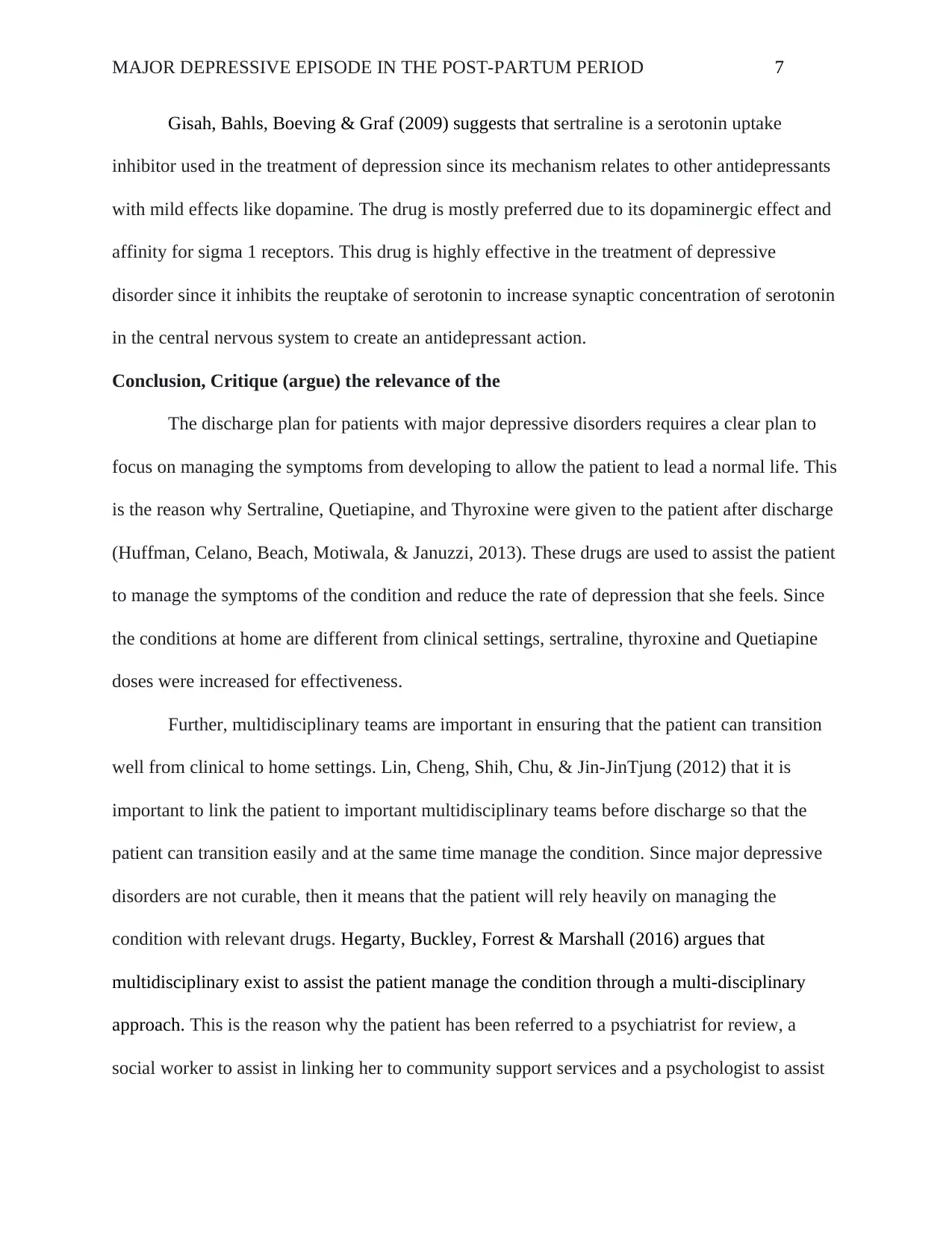
MAJOR DEPRESSIVE EPISODE IN THE POST-PARTUM PERIOD 7
Gisah, Bahls, Boeving & Graf (2009) suggests that sertraline is a serotonin uptake
inhibitor used in the treatment of depression since its mechanism relates to other antidepressants
with mild effects like dopamine. The drug is mostly preferred due to its dopaminergic effect and
affinity for sigma 1 receptors. This drug is highly effective in the treatment of depressive
disorder since it inhibits the reuptake of serotonin to increase synaptic concentration of serotonin
in the central nervous system to create an antidepressant action.
Conclusion, Critique (argue) the relevance of the
The discharge plan for patients with major depressive disorders requires a clear plan to
focus on managing the symptoms from developing to allow the patient to lead a normal life. This
is the reason why Sertraline, Quetiapine, and Thyroxine were given to the patient after discharge
(Huffman, Celano, Beach, Motiwala, & Januzzi, 2013). These drugs are used to assist the patient
to manage the symptoms of the condition and reduce the rate of depression that she feels. Since
the conditions at home are different from clinical settings, sertraline, thyroxine and Quetiapine
doses were increased for effectiveness.
Further, multidisciplinary teams are important in ensuring that the patient can transition
well from clinical to home settings. Lin, Cheng, Shih, Chu, & Jin-JinTjung (2012) that it is
important to link the patient to important multidisciplinary teams before discharge so that the
patient can transition easily and at the same time manage the condition. Since major depressive
disorders are not curable, then it means that the patient will rely heavily on managing the
condition with relevant drugs. Hegarty, Buckley, Forrest & Marshall (2016) argues that
multidisciplinary exist to assist the patient manage the condition through a multi-disciplinary
approach. This is the reason why the patient has been referred to a psychiatrist for review, a
social worker to assist in linking her to community support services and a psychologist to assist
Gisah, Bahls, Boeving & Graf (2009) suggests that sertraline is a serotonin uptake
inhibitor used in the treatment of depression since its mechanism relates to other antidepressants
with mild effects like dopamine. The drug is mostly preferred due to its dopaminergic effect and
affinity for sigma 1 receptors. This drug is highly effective in the treatment of depressive
disorder since it inhibits the reuptake of serotonin to increase synaptic concentration of serotonin
in the central nervous system to create an antidepressant action.
Conclusion, Critique (argue) the relevance of the
The discharge plan for patients with major depressive disorders requires a clear plan to
focus on managing the symptoms from developing to allow the patient to lead a normal life. This
is the reason why Sertraline, Quetiapine, and Thyroxine were given to the patient after discharge
(Huffman, Celano, Beach, Motiwala, & Januzzi, 2013). These drugs are used to assist the patient
to manage the symptoms of the condition and reduce the rate of depression that she feels. Since
the conditions at home are different from clinical settings, sertraline, thyroxine and Quetiapine
doses were increased for effectiveness.
Further, multidisciplinary teams are important in ensuring that the patient can transition
well from clinical to home settings. Lin, Cheng, Shih, Chu, & Jin-JinTjung (2012) that it is
important to link the patient to important multidisciplinary teams before discharge so that the
patient can transition easily and at the same time manage the condition. Since major depressive
disorders are not curable, then it means that the patient will rely heavily on managing the
condition with relevant drugs. Hegarty, Buckley, Forrest & Marshall (2016) argues that
multidisciplinary exist to assist the patient manage the condition through a multi-disciplinary
approach. This is the reason why the patient has been referred to a psychiatrist for review, a
social worker to assist in linking her to community support services and a psychologist to assist
Paraphrase This Document
Need a fresh take? Get an instant paraphrase of this document with our AI Paraphraser
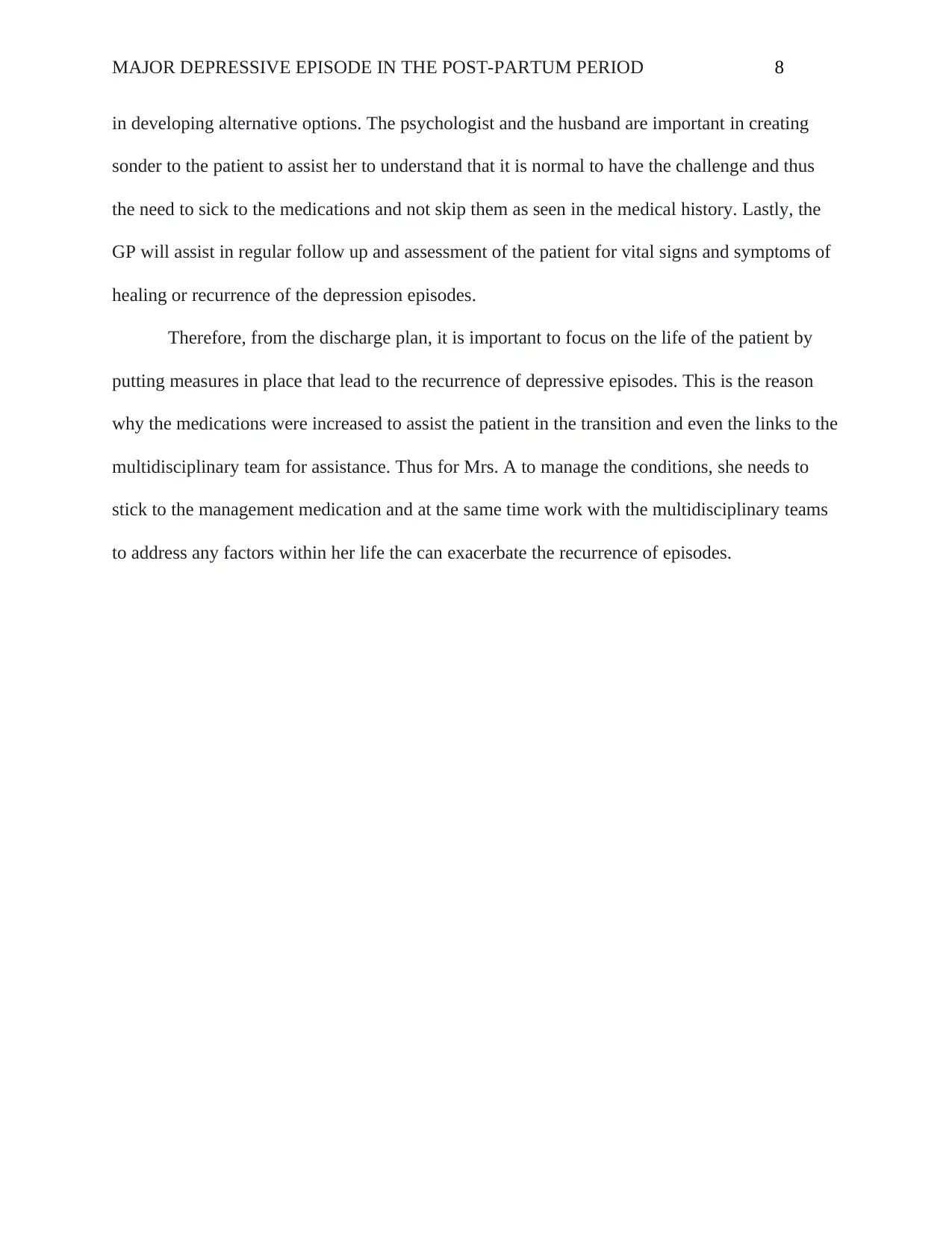
MAJOR DEPRESSIVE EPISODE IN THE POST-PARTUM PERIOD 8
in developing alternative options. The psychologist and the husband are important in creating
sonder to the patient to assist her to understand that it is normal to have the challenge and thus
the need to sick to the medications and not skip them as seen in the medical history. Lastly, the
GP will assist in regular follow up and assessment of the patient for vital signs and symptoms of
healing or recurrence of the depression episodes.
Therefore, from the discharge plan, it is important to focus on the life of the patient by
putting measures in place that lead to the recurrence of depressive episodes. This is the reason
why the medications were increased to assist the patient in the transition and even the links to the
multidisciplinary team for assistance. Thus for Mrs. A to manage the conditions, she needs to
stick to the management medication and at the same time work with the multidisciplinary teams
to address any factors within her life the can exacerbate the recurrence of episodes.
in developing alternative options. The psychologist and the husband are important in creating
sonder to the patient to assist her to understand that it is normal to have the challenge and thus
the need to sick to the medications and not skip them as seen in the medical history. Lastly, the
GP will assist in regular follow up and assessment of the patient for vital signs and symptoms of
healing or recurrence of the depression episodes.
Therefore, from the discharge plan, it is important to focus on the life of the patient by
putting measures in place that lead to the recurrence of depressive episodes. This is the reason
why the medications were increased to assist the patient in the transition and even the links to the
multidisciplinary team for assistance. Thus for Mrs. A to manage the conditions, she needs to
stick to the management medication and at the same time work with the multidisciplinary teams
to address any factors within her life the can exacerbate the recurrence of episodes.
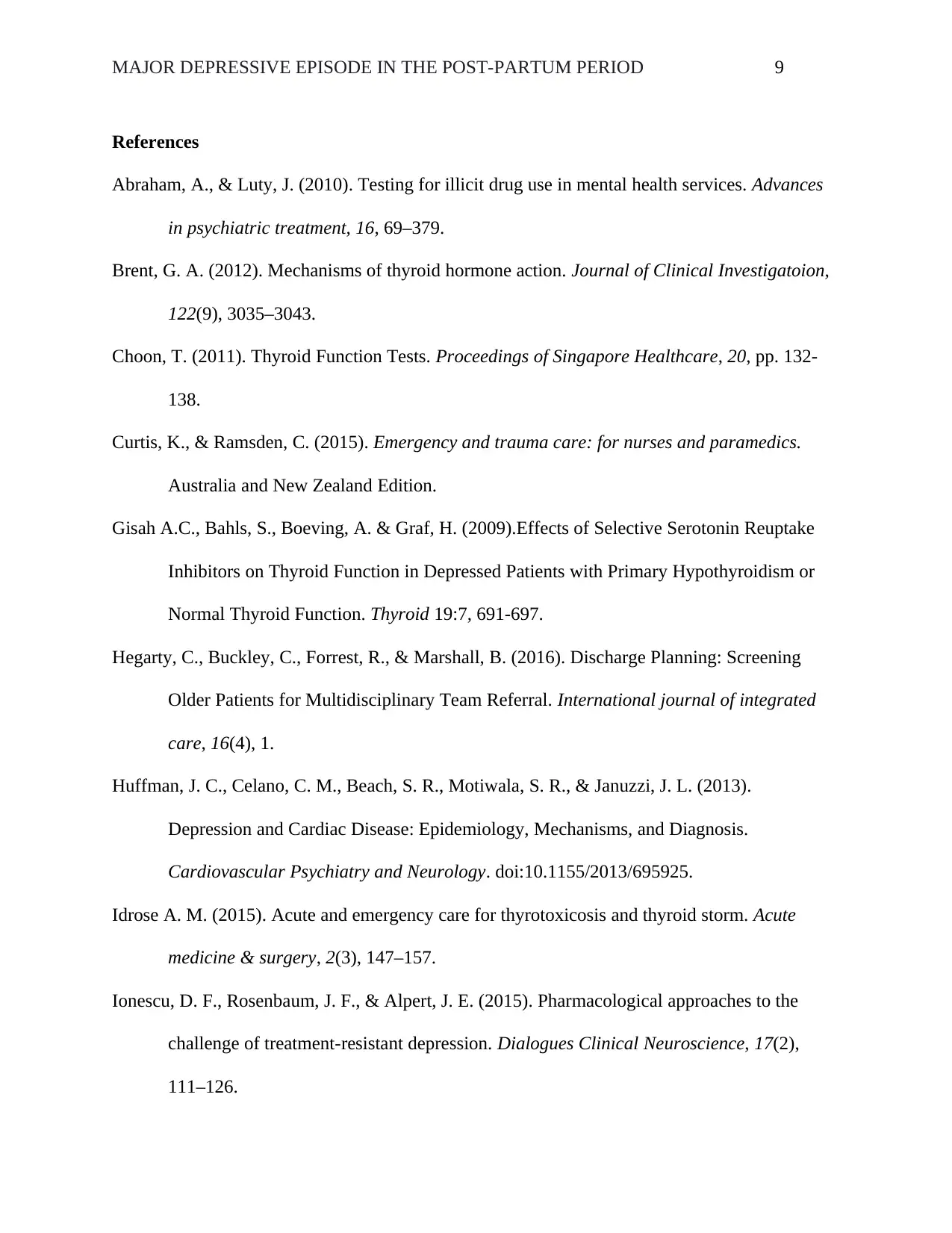
MAJOR DEPRESSIVE EPISODE IN THE POST-PARTUM PERIOD 9
References
Abraham, A., & Luty, J. (2010). Testing for illicit drug use in mental health services. Advances
in psychiatric treatment, 16, 69–379.
Brent, G. A. (2012). Mechanisms of thyroid hormone action. Journal of Clinical Investigatoion,
122(9), 3035–3043.
Choon, T. (2011). Thyroid Function Tests. Proceedings of Singapore Healthcare, 20, pp. 132-
138.
Curtis, K., & Ramsden, C. (2015). Emergency and trauma care: for nurses and paramedics.
Australia and New Zealand Edition.
Gisah A.C., Bahls, S., Boeving, A. & Graf, H. (2009).Effects of Selective Serotonin Reuptake
Inhibitors on Thyroid Function in Depressed Patients with Primary Hypothyroidism or
Normal Thyroid Function. Thyroid 19:7, 691-697.
Hegarty, C., Buckley, C., Forrest, R., & Marshall, B. (2016). Discharge Planning: Screening
Older Patients for Multidisciplinary Team Referral. International journal of integrated
care, 16(4), 1.
Huffman, J. C., Celano, C. M., Beach, S. R., Motiwala, S. R., & Januzzi, J. L. (2013).
Depression and Cardiac Disease: Epidemiology, Mechanisms, and Diagnosis.
Cardiovascular Psychiatry and Neurology. doi:10.1155/2013/695925.
Idrose A. M. (2015). Acute and emergency care for thyrotoxicosis and thyroid storm. Acute
medicine & surgery, 2(3), 147–157.
Ionescu, D. F., Rosenbaum, J. F., & Alpert, J. E. (2015). Pharmacological approaches to the
challenge of treatment-resistant depression. Dialogues Clinical Neuroscience, 17(2),
111–126.
References
Abraham, A., & Luty, J. (2010). Testing for illicit drug use in mental health services. Advances
in psychiatric treatment, 16, 69–379.
Brent, G. A. (2012). Mechanisms of thyroid hormone action. Journal of Clinical Investigatoion,
122(9), 3035–3043.
Choon, T. (2011). Thyroid Function Tests. Proceedings of Singapore Healthcare, 20, pp. 132-
138.
Curtis, K., & Ramsden, C. (2015). Emergency and trauma care: for nurses and paramedics.
Australia and New Zealand Edition.
Gisah A.C., Bahls, S., Boeving, A. & Graf, H. (2009).Effects of Selective Serotonin Reuptake
Inhibitors on Thyroid Function in Depressed Patients with Primary Hypothyroidism or
Normal Thyroid Function. Thyroid 19:7, 691-697.
Hegarty, C., Buckley, C., Forrest, R., & Marshall, B. (2016). Discharge Planning: Screening
Older Patients for Multidisciplinary Team Referral. International journal of integrated
care, 16(4), 1.
Huffman, J. C., Celano, C. M., Beach, S. R., Motiwala, S. R., & Januzzi, J. L. (2013).
Depression and Cardiac Disease: Epidemiology, Mechanisms, and Diagnosis.
Cardiovascular Psychiatry and Neurology. doi:10.1155/2013/695925.
Idrose A. M. (2015). Acute and emergency care for thyrotoxicosis and thyroid storm. Acute
medicine & surgery, 2(3), 147–157.
Ionescu, D. F., Rosenbaum, J. F., & Alpert, J. E. (2015). Pharmacological approaches to the
challenge of treatment-resistant depression. Dialogues Clinical Neuroscience, 17(2),
111–126.
⊘ This is a preview!⊘
Do you want full access?
Subscribe today to unlock all pages.

Trusted by 1+ million students worldwide
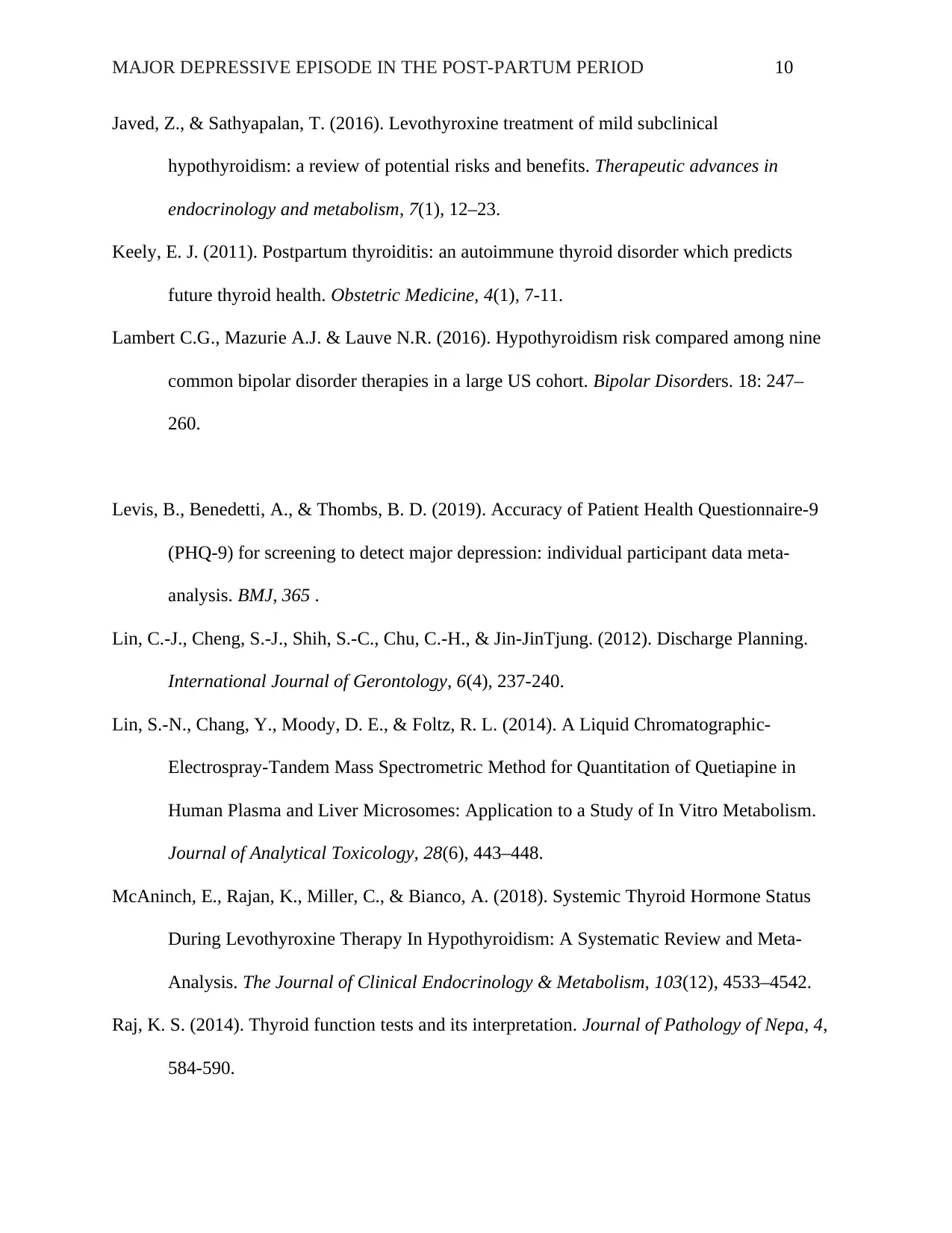
MAJOR DEPRESSIVE EPISODE IN THE POST-PARTUM PERIOD 10
Javed, Z., & Sathyapalan, T. (2016). Levothyroxine treatment of mild subclinical
hypothyroidism: a review of potential risks and benefits. Therapeutic advances in
endocrinology and metabolism, 7(1), 12–23.
Keely, E. J. (2011). Postpartum thyroiditis: an autoimmune thyroid disorder which predicts
future thyroid health. Obstetric Medicine, 4(1), 7-11.
Lambert C.G., Mazurie A.J. & Lauve N.R. (2016). Hypothyroidism risk compared among nine
common bipolar disorder therapies in a large US cohort. Bipolar Disorders. 18: 247–
260.
Levis, B., Benedetti, A., & Thombs, B. D. (2019). Accuracy of Patient Health Questionnaire-9
(PHQ-9) for screening to detect major depression: individual participant data meta-
analysis. BMJ, 365 .
Lin, C.-J., Cheng, S.-J., Shih, S.-C., Chu, C.-H., & Jin-JinTjung. (2012). Discharge Planning.
International Journal of Gerontology, 6(4), 237-240.
Lin, S.-N., Chang, Y., Moody, D. E., & Foltz, R. L. (2014). A Liquid Chromatographic-
Electrospray-Tandem Mass Spectrometric Method for Quantitation of Quetiapine in
Human Plasma and Liver Microsomes: Application to a Study of In Vitro Metabolism.
Journal of Analytical Toxicology, 28(6), 443–448.
McAninch, E., Rajan, K., Miller, C., & Bianco, A. (2018). Systemic Thyroid Hormone Status
During Levothyroxine Therapy In Hypothyroidism: A Systematic Review and Meta-
Analysis. The Journal of Clinical Endocrinology & Metabolism, 103(12), 4533–4542.
Raj, K. S. (2014). Thyroid function tests and its interpretation. Journal of Pathology of Nepa, 4,
584-590.
Javed, Z., & Sathyapalan, T. (2016). Levothyroxine treatment of mild subclinical
hypothyroidism: a review of potential risks and benefits. Therapeutic advances in
endocrinology and metabolism, 7(1), 12–23.
Keely, E. J. (2011). Postpartum thyroiditis: an autoimmune thyroid disorder which predicts
future thyroid health. Obstetric Medicine, 4(1), 7-11.
Lambert C.G., Mazurie A.J. & Lauve N.R. (2016). Hypothyroidism risk compared among nine
common bipolar disorder therapies in a large US cohort. Bipolar Disorders. 18: 247–
260.
Levis, B., Benedetti, A., & Thombs, B. D. (2019). Accuracy of Patient Health Questionnaire-9
(PHQ-9) for screening to detect major depression: individual participant data meta-
analysis. BMJ, 365 .
Lin, C.-J., Cheng, S.-J., Shih, S.-C., Chu, C.-H., & Jin-JinTjung. (2012). Discharge Planning.
International Journal of Gerontology, 6(4), 237-240.
Lin, S.-N., Chang, Y., Moody, D. E., & Foltz, R. L. (2014). A Liquid Chromatographic-
Electrospray-Tandem Mass Spectrometric Method for Quantitation of Quetiapine in
Human Plasma and Liver Microsomes: Application to a Study of In Vitro Metabolism.
Journal of Analytical Toxicology, 28(6), 443–448.
McAninch, E., Rajan, K., Miller, C., & Bianco, A. (2018). Systemic Thyroid Hormone Status
During Levothyroxine Therapy In Hypothyroidism: A Systematic Review and Meta-
Analysis. The Journal of Clinical Endocrinology & Metabolism, 103(12), 4533–4542.
Raj, K. S. (2014). Thyroid function tests and its interpretation. Journal of Pathology of Nepa, 4,
584-590.
Paraphrase This Document
Need a fresh take? Get an instant paraphrase of this document with our AI Paraphraser
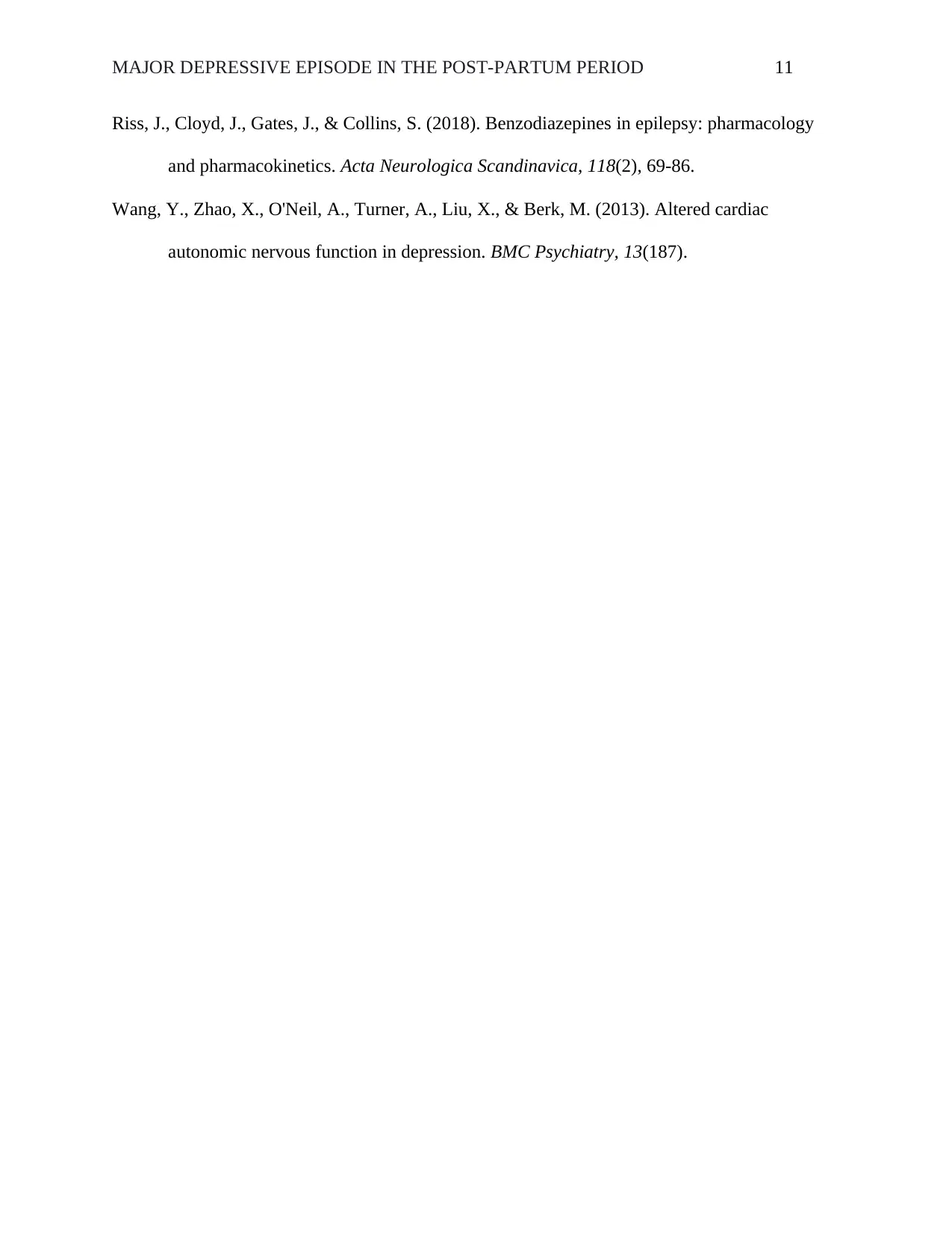
MAJOR DEPRESSIVE EPISODE IN THE POST-PARTUM PERIOD 11
Riss, J., Cloyd, J., Gates, J., & Collins, S. (2018). Benzodiazepines in epilepsy: pharmacology
and pharmacokinetics. Acta Neurologica Scandinavica, 118(2), 69-86.
Wang, Y., Zhao, X., O'Neil, A., Turner, A., Liu, X., & Berk, M. (2013). Altered cardiac
autonomic nervous function in depression. BMC Psychiatry, 13(187).
Riss, J., Cloyd, J., Gates, J., & Collins, S. (2018). Benzodiazepines in epilepsy: pharmacology
and pharmacokinetics. Acta Neurologica Scandinavica, 118(2), 69-86.
Wang, Y., Zhao, X., O'Neil, A., Turner, A., Liu, X., & Berk, M. (2013). Altered cardiac
autonomic nervous function in depression. BMC Psychiatry, 13(187).
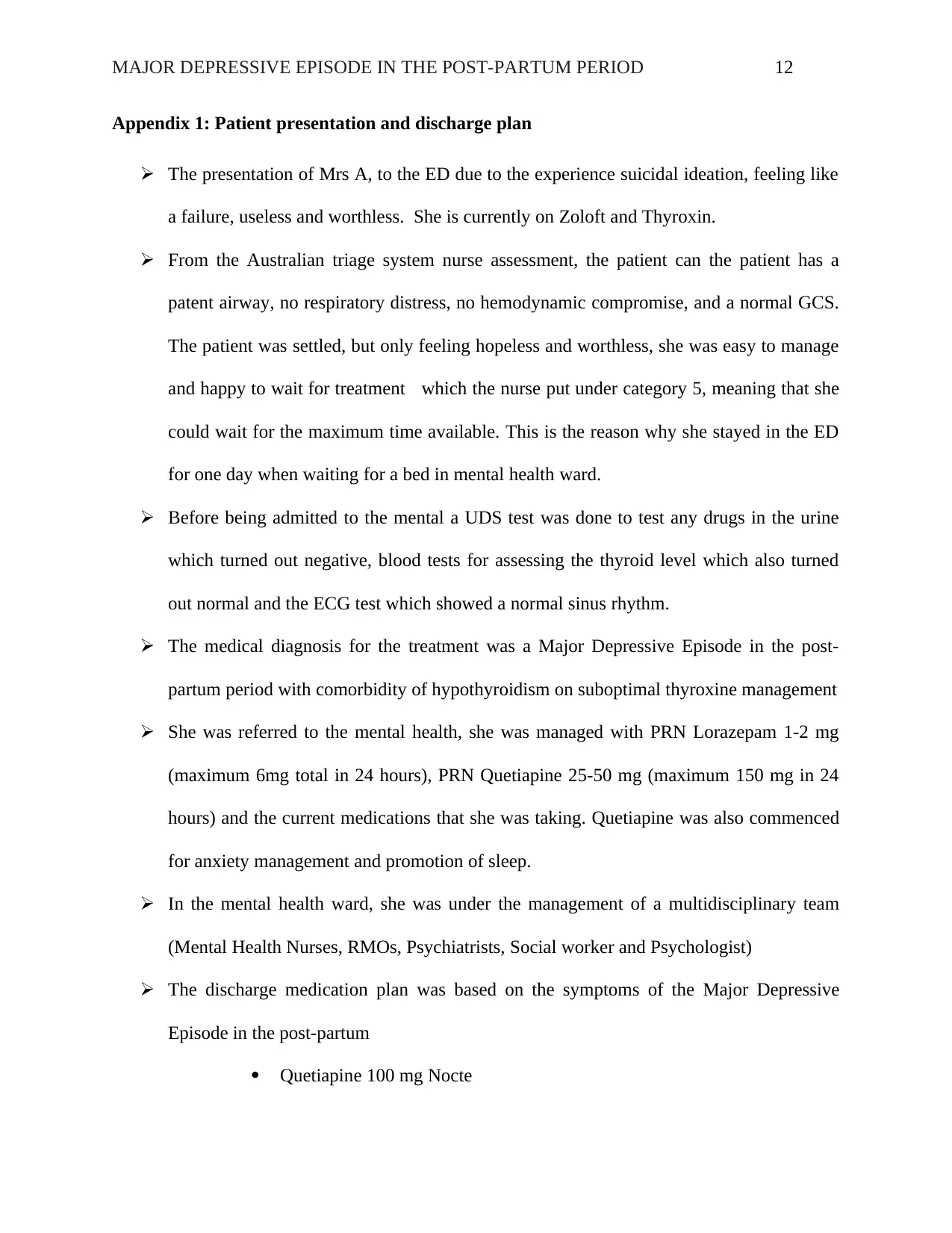
MAJOR DEPRESSIVE EPISODE IN THE POST-PARTUM PERIOD 12
Appendix 1: Patient presentation and discharge plan
The presentation of Mrs A, to the ED due to the experience suicidal ideation, feeling like
a failure, useless and worthless. She is currently on Zoloft and Thyroxin.
From the Australian triage system nurse assessment, the patient can the patient has a
patent airway, no respiratory distress, no hemodynamic compromise, and a normal GCS.
The patient was settled, but only feeling hopeless and worthless, she was easy to manage
and happy to wait for treatment which the nurse put under category 5, meaning that she
could wait for the maximum time available. This is the reason why she stayed in the ED
for one day when waiting for a bed in mental health ward.
Before being admitted to the mental a UDS test was done to test any drugs in the urine
which turned out negative, blood tests for assessing the thyroid level which also turned
out normal and the ECG test which showed a normal sinus rhythm.
The medical diagnosis for the treatment was a Major Depressive Episode in the post-
partum period with comorbidity of hypothyroidism on suboptimal thyroxine management
She was referred to the mental health, she was managed with PRN Lorazepam 1-2 mg
(maximum 6mg total in 24 hours), PRN Quetiapine 25-50 mg (maximum 150 mg in 24
hours) and the current medications that she was taking. Quetiapine was also commenced
for anxiety management and promotion of sleep.
In the mental health ward, she was under the management of a multidisciplinary team
(Mental Health Nurses, RMOs, Psychiatrists, Social worker and Psychologist)
The discharge medication plan was based on the symptoms of the Major Depressive
Episode in the post-partum
Quetiapine 100 mg Nocte
Appendix 1: Patient presentation and discharge plan
The presentation of Mrs A, to the ED due to the experience suicidal ideation, feeling like
a failure, useless and worthless. She is currently on Zoloft and Thyroxin.
From the Australian triage system nurse assessment, the patient can the patient has a
patent airway, no respiratory distress, no hemodynamic compromise, and a normal GCS.
The patient was settled, but only feeling hopeless and worthless, she was easy to manage
and happy to wait for treatment which the nurse put under category 5, meaning that she
could wait for the maximum time available. This is the reason why she stayed in the ED
for one day when waiting for a bed in mental health ward.
Before being admitted to the mental a UDS test was done to test any drugs in the urine
which turned out negative, blood tests for assessing the thyroid level which also turned
out normal and the ECG test which showed a normal sinus rhythm.
The medical diagnosis for the treatment was a Major Depressive Episode in the post-
partum period with comorbidity of hypothyroidism on suboptimal thyroxine management
She was referred to the mental health, she was managed with PRN Lorazepam 1-2 mg
(maximum 6mg total in 24 hours), PRN Quetiapine 25-50 mg (maximum 150 mg in 24
hours) and the current medications that she was taking. Quetiapine was also commenced
for anxiety management and promotion of sleep.
In the mental health ward, she was under the management of a multidisciplinary team
(Mental Health Nurses, RMOs, Psychiatrists, Social worker and Psychologist)
The discharge medication plan was based on the symptoms of the Major Depressive
Episode in the post-partum
Quetiapine 100 mg Nocte
⊘ This is a preview!⊘
Do you want full access?
Subscribe today to unlock all pages.

Trusted by 1+ million students worldwide
1 out of 13
Related Documents
Your All-in-One AI-Powered Toolkit for Academic Success.
+13062052269
info@desklib.com
Available 24*7 on WhatsApp / Email
![[object Object]](/_next/static/media/star-bottom.7253800d.svg)
Unlock your academic potential
Copyright © 2020–2025 A2Z Services. All Rights Reserved. Developed and managed by ZUCOL.





